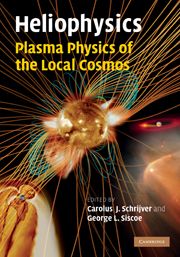Book contents
- Frontmatter
- Contents
- Preface
- 1 Prologue
- 2 Introduction to heliophysics
- 3 Creation and destruction of magnetic field
- 4 Magnetic field topology
- 5 Magnetic reconnection
- 6 Structures of the magnetic field
- 7 Turbulence in space plasmas
- 8 The solar atmosphere
- 9 Stellar winds and magnetic fields
- 10 Fundamentals of planetary magnetospheres
- 11 Solar-wind– magnetosphere coupling: an MHD perspective
- 12 On the ionosphere and chromosphere
- 13 Comparative planetary environments
- Appendix I Authors and editors
- List of illustrations
- List of tables
- References
- Index
8 - The solar atmosphere
Published online by Cambridge University Press: 05 August 2013
- Frontmatter
- Contents
- Preface
- 1 Prologue
- 2 Introduction to heliophysics
- 3 Creation and destruction of magnetic field
- 4 Magnetic field topology
- 5 Magnetic reconnection
- 6 Structures of the magnetic field
- 7 Turbulence in space plasmas
- 8 The solar atmosphere
- 9 Stellar winds and magnetic fields
- 10 Fundamentals of planetary magnetospheres
- 11 Solar-wind– magnetosphere coupling: an MHD perspective
- 12 On the ionosphere and chromosphere
- 13 Comparative planetary environments
- Appendix I Authors and editors
- List of illustrations
- List of tables
- References
- Index
Summary
Introduction
The Sun is an average main-sequence star in middle age and of spectral class G2 v. The Sun has mass M⊙ = 2 × 1030 kg, radius R⊙ = 700 Mm, and effective temperature Teff = 5780 K. The spectral class G2 v implies that the energy generated by hydrogen fusing into helium in the solar core is carried by convection in the outer one-third of the Sun's envelope. Lighter main-sequence stars, of spectral classes K and M, have convection zones that extend steadily more deeply as the stars become less massive. Conversely, main-sequence stars heavier than the Sun, of spectral classes F and A, are convective only in a thin layer near their surface. The heaviest main-sequence stars, of spectral classes B and O, have convective cores but no convection near the surface. It is the convective motions in a stratified environment, coupled with differential rotation, that are ultimately responsible for solar and stellar dynamos and thus solar magnetic fields and solar and stellar activity. As the Sun is a middle-aged star, the solar wind has had time to carry away a large fraction of the initial angular momentum of the proto-solar cloud (see Vol. III). At present the Sun's rotation period ranges from 35 days at the poles to 25 days at the equator, but it was presumably much shorter early in the Sun's life, 4.5 Gyr ago.
- Type
- Chapter
- Information
- Heliophysics: Plasma Physics of the Local Cosmos , pp. 195 - 224Publisher: Cambridge University PressPrint publication year: 2009



